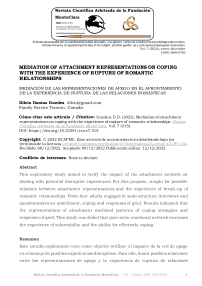Mediation of attachment representations on coping with the experience of rupture of romantic relationships
Автор: Dilcio Dantas Guedes
Журнал: Revista Científica Arbitrada de la Fundación MenteClara @fundacionmenteclara
Рубрика: Artículos
Статья в выпуске: 1, Vol. 7, 2022 года.
Бесплатный доступ
This exploratory study aimed to verify the impact of the attachment network on dealing with potential disruptive experiences. For this purpose, sought for possible relations between attachment representations and the experience of break-up of romantic relationships. Forty-four adults engaged in semi-structure interviews and questionnaires on attachment, coping and responses of grief. Results indicated that the representations of attachment mediated patterns of coping strategies and responses of grief. This study concluded that poor socio-emotional network increases the experience of vulnerability and the ability for effectively coping.
Attachment, Vulnerability, Disruption, Romantic Relationship, Rupture
Короткий адрес: https://sciup.org/170207611
IDR: 170207611 | DOI: 10.32351/rca.v7.315
Список литературы Mediation of attachment representations on coping with the experience of rupture of romantic relationships
- Ainsworth, M.D.S., Blehar, M.C., Waters, E., et Wall, S. (1978). Patterns of attachment. Erlbaum.
- Benyakar, M. (2006). Lo Disruptivo – Amenazas Individuales y Colectivas. Biblos.
- Bowlby, J. (1969). Attachment and Loss – Attachment. Hogarth Press.
- Bowlby, J. (1973). Attachment and Loss – Separation: anxiety and anger. Hogarth Press.
- Bowlby, J. (1980). Attachment and Loss – Loss. Hogarth Press.
- Bretherton, I. (1990). Communication patterns, internal working models and intergenerational transmission of attachment. Infant Mental Health Journal, 11(3), 237-252.
- Bretherton, I. & Munholland, K. (1999). Internal working models in attachment relationships. In: J. Cassidy & P. Shaver. Handbook of Attachment (pp. 89-111). The Guildford Press.
- Carver, C.S. (1997); You want to measure coping but your protocol's too long: consider the brief COPE. International Journal of Behavioral Medicine, 4(1), 92-100.
- Cohin, E., & Miljkovitch, R. (2007). La mise en place des représentations d’attachement au sein du couple : parts relatives à l’enfance et au conjoint. Psychologie Française, 52, 519-533, doi: https://dx.doi.org/10.3406/gazar.1975.2423
- Cyrulnik, B., Delage, M., & Blein, M.-N. (2007). Modification des styles d’attachement après le premier amour. Annales Médico-Psychologiques, 165,154-161, doi: https://dx.doi.org/10.1016/j.amp.2005.12.019
- Fairbairn, W.R.D. (1994). From instinct to self: selected paper of W.R.D. Fairbairn (Vols. 1-2). Aronson.
- Guedes, D.D. & Moreira, P. (2020). Dès les relations avec les parents à la relation conjugale : la continuité et la discontinuité des modèles d’attachement. Revista Subjetividades, 19(1), 104-114. https://dx.doi.org/10.5020/23590777.rs.v19i1.e5302
- Kobak, R.R. & Hazan, C. (1991). Attachment in marriage: effects of security and accuracy of working models. Journal of Personality and Social Psychology, 60, 861-869.
- Kunce, L., & Shaver, P. (1994). An attachment-theoretical approach to caregiving in romantic relationships. In: K. Bartholomew & D. Perman. Advances in personal relationship (pp. 205-237). Jessika Kingslay.
- Lev, E., Munro, B.H., & McCorkle, R. (1993). A shortened version of an instrument measuring grief. International Journal of Nursing Studies, 30(3), 213-26. doi: https://dx.doi.org/10.1016/0020-7489(93)90032-p PMID: 8335431.
- Main, M. & Solomon, J. (1986). Discovery of a new insecure –disorganized/disoriented attachment pattern. In: T.B. Brazelton & M. Yongman. Affective development in infancy (pp. 95-124). Ablex.
- Main, M. (1990). Cross-Cultural Studies of Attachment Organization: Recent Studies, Changing Methodologies, and the Concept of Conditional Strategies. Human Development, 33, 48-61. doi: https://dx.doi.org/10.1159/000276502
- Miljkovitch, R. (2001). L’attachement au Cours de la Vie. Presses Universitaires de France.
- Miljkovitch, R. (2003). Amour et ruptures. Les traces laissées par l’enfance. Perspectives Psychiatriques, 42, 108-114.
- Miljkovitch, R. (2009). Amour et ruptures. Les traces laissées par l’enfance. PUF.
- Montenegro, A. F. (2000). Psicologia do povo cearense. Programa Editorial Casa de José de Alencar.
- Pierrehumbert, B., Ramstein, T., Karmaniola, A. et al. (1996). Child care in the preschool years: Attachment, behaviour problems and cognitive development. European Journal Psychology Education, 11, 201. https://doi.org/10.1007/BF03172725
- Pierrehumbert, B. & Milijkovitch, R. (2000). La présomption de continuité des modèles d’attachement. Initiation ou entrave à la création scientifique ? In : G. Tarabulsy ; S. Larose ; R. Pederson et G. Moran (2000). Attachement et développement : le rôle des premières relations dans le développement humain (pp. 205-234). P.U. Québec.
- Zukerfeld, R. & Zonis Zukerfeld, R. (2016). Procesos terciarios: De la vulnerabilidad a la resiliencia. Editorial Lugar.


